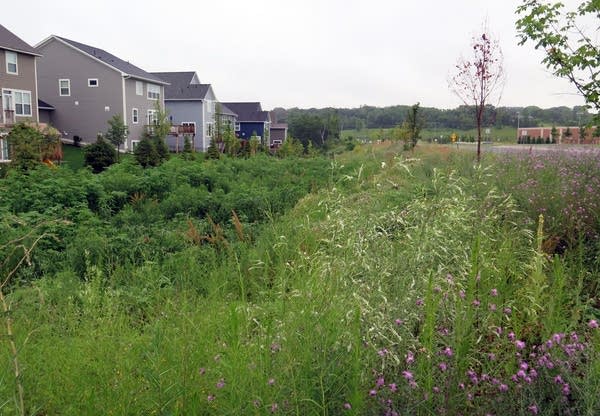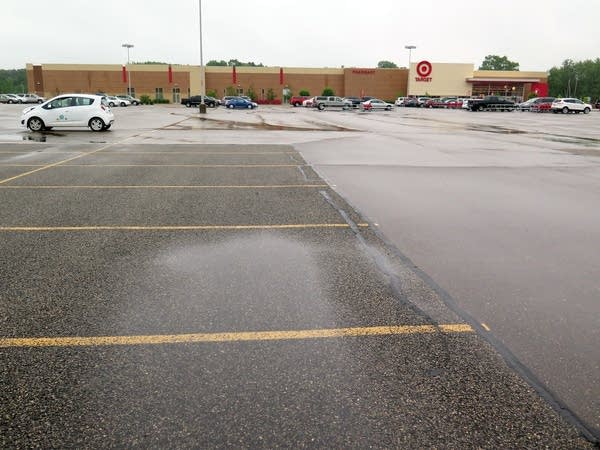Minnesota rain gardens go big to fight pollution, reuse water

Go Deeper.
Create an account or log in to save stories.
Like this?
Thanks for liking this story! We have added it to a list of your favorite stories.
With its Target store and mix of single family homes, Argenta Hills looks like any typical suburban tract. But it's anything but typical when it rains.
Instead of traditional gutters and catch basins, the Inver Grove Heights development has cuts in the curb for stormwater to flow into rain gardens where plants soak it up. Part of the massive Target parking lot and some road intersections are porous, allowing water to seep into the ground. For bigger storms, low-lying basins collect the excess and prevent flooding.
You won't find another like it in Minnesota. It's as if the whole area is one giant rain garden spanning more than 3,000 acres because when it rains, all the water stays on site. There are no underground pipes to carry it away to the Mississippi River.
"I don't think people even recognize that that's stormwater treatment," said Brett Emmons, an engineer with Emmons and Olivier Resources, which helped design the system.
Turn Up Your Support
MPR News helps you turn down the noise and build shared understanding. Turn up your support for this public resource and keep trusted journalism accessible to all.

Many Minnesota cities use rain gardens and other "green infrastructure" now to keep stormwater from polluting nearby lakes and rivers. But they're often small, neighborhood efforts. Inver Grove Heights, however, is putting that stormwater science to use on a massive scale at Argenta Hills, and it's attracting national attention.
It was one of eight engineering projects this year to receive top awards from the American Council of Engineering Companies. Others included fancy transit stations in Denver and New York City and an earthquake-proof bridge in the San Francisco Bay area.
Emmons says in its first five years, the system is performing better than expected, showing green infrastructure's potential.
"This is kind of almost hidden or woven into the site in a way that isn't so obvious but it does its job, at the same time it can be attractive," he said. "This site and this whole area of Inver Grove Heights is proof that it can have a major, major impact."
While the Inver Grove Heights project may be the biggest, the Twin Cities metropolitan area boasts stormwater projects that are equally ambitious.
On University Avenue in St. Paul, for instance, the storm drains look pretty normal, but they're not. They've been re-engineered.

"Before, all the rain would just come right down to this catch basin and into a pipe and go straight to the river," Mark Doneux of the Capitol Region Watershed District explained on a recent street tour. "What happens now along this stretch of University Avenue is these catch basins are actually going into a rock trench that feed the roots of the trees."
About 1,000 trees line several miles of University Avenue, helping reduce the area's stormwater runoff by over 50 percent. Doneux said that's as high as they could get in an area that's fully developed with the existing buildings and a new light rail line.
These aren't novelty science projects. Experts say climate change is forcing city leaders and engineers across Minnesota to find ways to manage what happens when it rains.
For instance, a typical once-in-a-decade storm drops about 4.5 inches now, but the rainfall in those storms could rise 33 percent by 2050, swamping storm sewers that weren't built for it, said John Gulliver, a civil engineering professor at the University of Minnesota's St. Anthony Falls Laboratory.
But replacing the pipes shouldn't be the first solution, said Gulliver, who has researched green infrastructure for more than a decade.
"There are situations where green infrastructure can alleviate the need to replace the storm sewer," he said. "It's expensive to dig up the street, so it's possible you could even save money if you do it with green infrastructure."
He acknowledged that in most existing urban areas, green infrastructure won't replace storm sewers because there isn't enough open space to capture the biggest storms.

That wasn't a problem in Argenta Hills. Inver Grove Heights Public Works Director Scott Thureen says the development might not have happened at all without the innovative stormwater system. The area is far from a stream or river where water could be discharged, and people balked at the estimate for a conventional system of pipes and pumps.
"It got everybody's attention, and property owners who had already been talking to developers were coming back saying that price is too high," he said.
In the end, that conventional system, including the required maintenance over the years, would have been twice the cost of the system the city adopted. With the green engineering, the area can handle back-to-back "100-year" storms as well as a rapid, sizable snow melt, he added.

Green isn't always cheaper. Permeable pavement, for example, can cost two to three times as much as traditional surfaces, though the cost has been coming down. So cities are trying to be strategic about where and when they adopt the practices. In most cases, it's when they're adding a new development or reconstructing an existing area.
While the data are still coming in on how much green infrastructure can improve a lake or river, Minnesota's urban areas need to think about rainwater differently, said Anne Gelbmann, who coordinates green infrastructure efforts at the Minnesota Pollution Control Agency.
The agency now gives first preference to practices in stormwater permit applications that keep that dirty, urban stormwater brew out of lakes and rivers, she said, adding, "I would really like to see people think of rain as a resource and not just something we have to get rid of."
Dear reader,
Political debates with family or friends can get heated. But what if there was a way to handle them better?
You can learn how to have civil political conversations with our new e-book!
Download our free e-book, Talking Sense: Have Hard Political Conversations, Better, and learn how to talk without the tension.



